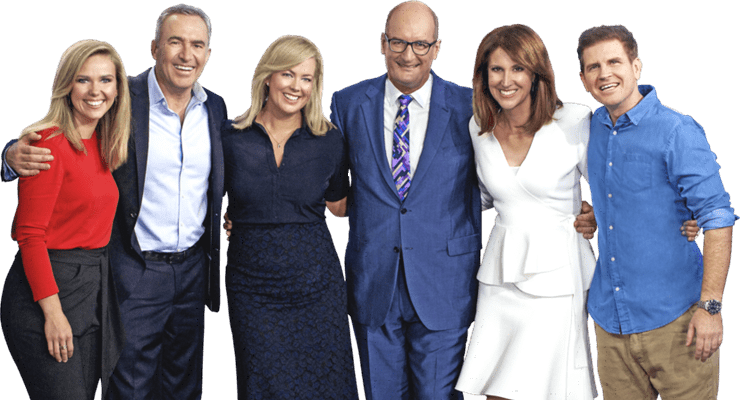
Television news in Australia is overwhelmingly white, and does not reflect the diversity of our multicultural population, a new study has found.
According to a report compiled by Media Diversity Australia (MDA) and four major universities, 75% of presenters, commentators and reporters have an Anglo-Celtic background, while just 6% have an Indigenous or non-European background.
More than 70% of respondents to a survey of television journalists agreed that representation of culturally and linguistically diverse Australians was either poor or very poor.
And almost 80% of television journalists surveyed from a culturally diverse background felt their identity was a barrier to career advancement.
Whiteness from the top down
Recent data indicates 24% of the Australian population is from an Indigenous or non-white background. So why does our television news remain so stubbornly white? One key reason is a lack of diversity in senior leadership roles.
Every single national television news director in the country is a white man. The boards of TV networks are almost entirely white. Almost 90% of the 32 people in the most senior management roles are white.
The media isn’t alone here. A 2018 report conducted by the Australian Human Rights Commission (AHRC) found just 5% of senior leaders in business, politics, government and higher education are from an Indigenous or non-European background.
That lack of whiteness at the top trickles down and influences a newsroom’s daily editorial decisions.
“We continue to see all-white panels who are there to comment on issues impacting our very multicultural nation — on both commercial TV and the ABC,” MDA chair Isabel Lo said.
“Unless we see change in both the composition of leadership teams and talent on screen, our media will remain disconnected from audiences whose engagement is already waning.”
A missed opportunity?
The MDA report comes after the ripple-effect of Black Lives Matter (BLM) protests brought some long-awaited attention to the glaring lack of diversity in Australia’s media sector.
The ABC’s Insiders program came under fire for having an all-white panel discuss BLM protests, and analysis by Junkee later showed the program hadn’t featured a single non-white panelist in its entire history.
The lack of diversity extended beyond the commercial channels to SBS, the multicultural broadcaster, which also has an overwhelmingly white board, and recently had to respond to allegations from Indigenous journalists that they’d faced racism and bullying in the newsroom.
And an open letter signed by 70 journalists at The Age denounced the paper’s lack of diversity. The Age has only had one Indigenous reporter in its entire 166 year history, the letter pointed out.
But over a month later, momentum has sputtered, and we’re yet to see whether those calls for greater newsroom diversity have been matched with action.
Worst offenders on the defensive
The report also found that media companies have a lot further to go than others on the diversity front. Just 2.9% of Nine’s presenters, commentators or reporters were from an Indigenous or non-European background. And Seven fared little better, with 4.8%.
The worst offenders on the diversity front, Seven and Nine, also reacted the most disingenuously to the report. Speaking to News.com.au, Nine news director Darren Wick said the report had “clear errors” and overlooked Gamilaroi woman and Today reporter Brooke Boney.
Seven director of news and public affairs Craig Mcpherson said the report was “shallow,” and claimed the lack of diversity on his network was a result of non-white people simply not applying.
Both networks have repeatedly come under fire for racist incidents on their breakfast TV shows in recent years. Seven is currently being sued for racial discrimination over a 2018 Sunrise panel where a commentator called for another stolen generation.
Sunrise and Today, its Nine rival, have also given ample airtime to a host of far-right grifters, from Pauline Hanson, whose career was resurrected by breakfast TV, to British reactionary Katie Hopkins.








Fussing about how presenters look for is deeply insincere. A journalist’s job is to communicate, not decorate. If we are concerned that recent migrants and refugees understand the detail in the news, we should be militantly ensuring that all presenters speak top-quality Australian English. That’s “ABC English” to most of us, and “adapted Received Pronunciation” to any pommophiles still lurking in Auntie’s bosom.
White males, probably predominate. How many females in leading news roles? The headline photo shows equality in genders but is it representative of reality?
Is it representative of reality ?? No….It’s certainly a middleclass ‘classless act’ nearly all round..
Why was SBS left out of the survey?
I’ve been watching news on Auntie quite a bit lately, and it seems to me that they are at least making an effort when it comes to diversity, even if the exact numbers around representation aren’t there yet. Quite a few of their younger reporters, for example, are non-Anglo.
As far as the commercial networks are concerned, that’s just it. They’re commercial. They exist to make money. People such as the author can bleat all they want. Commercial TV stations are not instruments of social justice. They are instruments of profits for their owners.
And for broadcast media, maximum profit requires maximum audiences.
You can’t have it both ways there, I’m afraid. Twenty four per cent of the population may be indigenous or non-white, but that means seventy six per cent aren’t. So if commercial TV networks want to maximise their audience and hence profit, it’s the Anglo part of the population they have to pursue. And if ethnicity of presenter impacts on appeal to the audience, that means the majority of the presenters need to be Anglo as well. Or else you have to say that ethnicity of presenter shouldn’t matter to Anglo audiences, in which case, they shouldn’t matter to non-Anglo audiences either and the status quo can remain.
Which also means choosing to use the cast of Sunrise as the lead image is a bit duplicitous.
What’s the linkage between successful at ‘commercial’ and not being diverse? Conversely, if there was more diversity it may well be embraced but viewers, if not why not?
The Drum does a good job of having a diverse selection of guests, including aboriginal Australians.
I agree…but the problem with that is, no matter what issue is being discussed, many indigenous people on the panel can only talk about indigenous aspects, which quite often don’t bear any useful association with the matter under discussion. It might make sense to them, but I find it a distraction.
However, on any TV news/current affairs program, which is predominately about indigenous issues, they should be very well represented…same goes for other minority groups.
At least The Drum has stopped inviting Josephine Cashman on its panel. She came across as an ignorant motormouth when she was on, and I wrote to the ABC several times to point this out. Finally she over-reached in her criticism of Bruce Pascoe and has now been delisted.